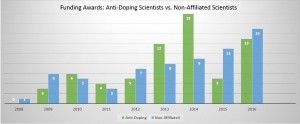A common misconception about anti-doping science is that practitioners of research in this field are all associated with anti-doping laboratories. In fact, the majority of investigators we fund represent numerous fields of science (from analytical chemistry to physiology), and conduct their projects within academic institutions and industry laboratories. Of the 69* distinct primary investigators the PCC has funded since 2008, 49, or 70%, fit into this category.
Such investigators are encouraged to apply for PCC grants if they believe their area of science may be applicable to one of the many challenges currently facing the anti-doping sphere, from increasing the sensitivity of biomarker quantification, to determining analytical strategies for detecting designer drugs, and beyond. The PCC believes engaging researchers with different skill sets, approaches, and perspectives provides the best opportunity to efficiently solve multi-faceted problems. In many cases, scientists from outside fields are able to extrapolate their current area of study to an anti-doping setting (for instance, Dr. Kiriakous’ currently funded work with Raman spectroscopy). Due to the vast knowledge available across the scientific landscape, facilitating collaboration amongst experts is also encouraged by the PCC, and the strategy behind PCC Working Groups (one of which recently implemented a new test for Growth Hormone detection in Wada labs). It is also highly encouraged for investigators without anti-doping experience to consult and/or collaborate with anti-doping scientists. The context such experts can provide regarding the needs of the sphere and conditions for real-world applicability will ensure potential research is designed with the best potential chance for adoption (and thus, PCC funding).
The PCC certainly still funds career anti-doping scientists, with a majority of total awards (50.4%) being granted to this demographic. While fewer investigators make up this category (20/69), they are awarded more regularly than outside investigators for several reasons. As a career anti-doping scientist, evolving technology in this domain is a core research priority, and thus multiple projects (and funding) to this end are pursued over many years. By contrast, scientists without WADA affiliation are typically only funded by the PCC one time. Scientists working daily within WADA-Accredited labs also best understand, and can articulate, a) what existing anti-doping challenge their research will attempt to solve and b) how the research may be applied in a real-world setting – two areas where non-affiliated scientists often fall short during the application process.
The breakdown of funding for each group, by number of awards per year, is as follows:
Note: the above data is inclusive of awards for PCC Working groups, and Center of Excellence equipment grants.
Both career anti-doping scientists and investigators willing to contribute their knowledge to the field are vital to ensure anti-doping technology and practice continue to evolve. If you believe your scientific area of expertise may be useful within an anti-doping setting, apply for a grant, or reach out to discuss your work.
*This number is not inclusive of the many co-recipients, post-docs, and research assistants contributing to PCC funded projects.






